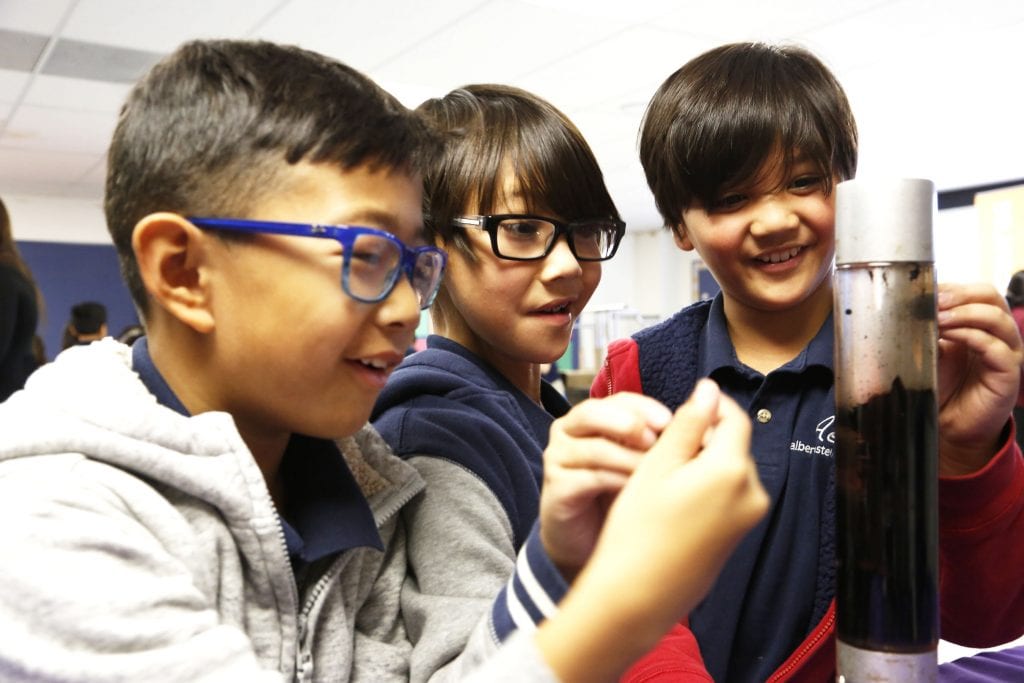Standing in a crowd of classmates, third grade student Tyler Jackson, 8, worked to move a grip-mounted loop through a large wire maze without setting off the game’s buzzer.
The steady-hand game, called Buzz Wire, requires students to carefully move the metal loop throughout the maze while also teaching them about the configuration of electrical circuits.
“It’s super fun and you have to try to beat it,” Jackson said.
The Buzz Wire game was just one of nine exhibits on display at Albert Einstein STEAM Academy as part of an all-day STEAM (Science, Technology, Engineering, Art and Math) assembly for students of all grade levels.
“It’s great that we can bring the kids these types of assemblies,” Principal Raffi Martinian said. “It includes our core identity so it’s about STEAM and understanding what that is with science, technology, engineering, arts and math, and about how all those subjects integrate in the classroom.”

The assembly and mobile STEAM Museum was brought to the elementary school by Mobile Ed Productions Inc., a company that brings educational assemblies and workshops to students throughout the United States.
“It’s fun, this is what I like doing. I taught elementary school and secondary school and physical sciences for 26 years,” said Paul DeCunzo or “Mr. D.,” an independent contractor with Mobile Ed Productions, Inc. “I know all the exhibits; I get to work with different gadgets and schools each day.”
During the assembly, students rotated to different dynamic STEAM stations throughout the mobile museum that included robotics, 3-D printers, gears and more.

“The music maker is really cool because you can make your music with your friends,” third grade student Sarah Chelland, 8, said of the machine that produced different sounds after students pressed buttons and levers.
Other favorites for the students were a bike generation station where students could create kinetic energy and illuminate lights by pedaling a bicycle and a humanoid robot that displayed human-like abilities and led the students in the Macarena dance.
“Even though they seem like toys, they’re learning how to build and design and create with things they use every day,” third grade teacher Drew Wright said. “They’re learning the science behind it and all the different aspects of STEAM.”

Martinian noted that the hands-on aspect of the exhibit helped students learn in real-time and form connections between classroom lessons and outside applications.
“Connection is the real key, to see a connection between various subjects,” he said. “We want them to trust in things, to ask questions, getting them to do that hands-on work and have that inquiry.”
As they traveled to different stations the students also learned about invention, problem solving and team building as they worked together to accomplish tasks.
“They’re learning teamwork with the blocks they build together, they’re working on cheering each other and learning how to do design and problem solve,” Martinian said.

Wright noted that the mobile museum also inspired her and her colleagues to think outside of the box.
“We bring this into the classroom with different kinds of technology, but this inspires us as teachers to see that things are doable like a science experiment kids could make,” she said.
For Sarah Chellah, she hopes this experiment might be the design and construction of a unique robot.
“I made a robot before but it took me like three weeks to build,” Chelland said. “It was small but mine was different from everyone else’s because I’m in Girls Robotics at the Boys and Girls Club.”
[email protected]
661-287-5575
On Twitter as @_ChristinaCox_








